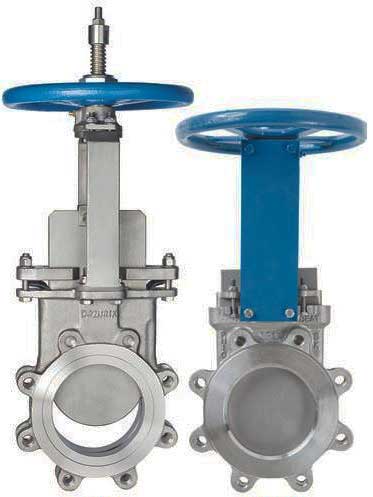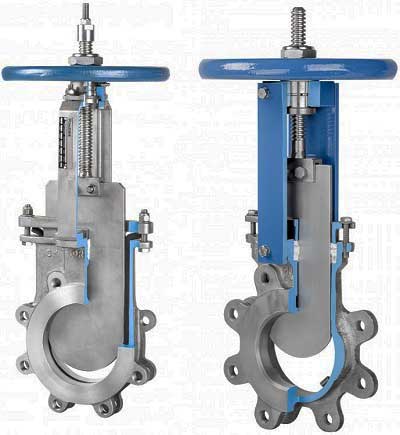Knife Gate Valve
Knife gate valves are specially designed for on-off and isolation in systems with high dissolved solids content
Knife Gate Valves began their journey in the Swedish pulp and paper industry in 1927. The market demanded a low-cost valve for pulpstock applications and the revolutionary knife gate valve design was born. Since then, knife gate valves have traveled back and forth around the world and undergone several changes; the Push-Through Knife Gate was developed in the United States and the Guided Shear Gate in Switzerland.
Although we have accepted the term "knife gate" as a generic name for each version of this valve, you may be surprised to discover that only the Guided-Shear Gate and its higher caliber adaptation, the Severe Service Knife Gate Valve can truly "slice" through media like a knife.

What is a Knife Gate Valve?
Knife gate valves are specifically designed for on-off and isolation in systems with high dissolved solids content. Knife gate valves are extremely useful when dealing with slurry, abrasive, corrosive and viscous media. The valves have a low pressure drop in the fully open position, are easy to operate, lightweight and cost-effective.
Knife valves are designed to operate under the harshest conditions, with a sharpened blade to cut through heavy liquids.
They are extremely useful in wastewater applications where corrosion is a major problem. In addition to the valve design being optimized for slurry media, a knife gate valve made of acid-resistant stainless steel is advantageous because it is less susceptible to corrosion damage and therefore requires less frequent maintenance or even replacement.
Knife gate valves should always be used for applications requiring a fully open or fully closed position and should not be used to control flow unless specifically designed for it. When fluid is pressed against a partially closed valve, a vibration is created that gradually erodes the disc and seat. In addition, knife gate valves are designed to open and close slowly to protect against the effects of water hammer.
Classification of Knife Gate Valve
On body material
Knife gate valves are made from a variety of materials. Cast steel, cast iron, ductile iron, bronze, nickel, alloy steel, stainless steel and forged steel are examples of commonly used materials. The material used in gate valves is primarily determined by the fluid application and design temperature.
Carbon steel knife gate valve is a strong material with high hardness, tensile strength and impact value. It is often used in industrial plants for high temperature and pressure operations.
Despite its high cost, the stainless steel knife gate valve has higher corrosion resistance, heat resistance, low temperature resistance and mechanical strength.
Lined valves are inherently thermally stable, chemically resistant and have excellent mechanical properties. Its superior processability allows for fine lining of valve wetted parts without fear of pinholes. It is also recommended for food processing because it is colorless and requires no additives or pigments.
By connection type
Valve end connection is mainly determined by the requirement and suitability of the valve, such as wafer type knife gate valve and lug type knife gate valve are used with less expensive valves, flanged type end is the most common of all types, and a gasket is used for sealing.
Sealing method.. Metal seat / Resilient seat
Before the introduction of the knife gate valve with resilient seat, knife gate valves with metal seat were commonly used. To ensure a good seal, the tapered wedge design and angular sealing elements of a metal-seated wedge necessitate a dip in the valve base. Sand and pebbles are still trapped in the bore. No matter how well the pipe is flushed during installation or repair, the piping system will never be completely free of impurities. As a result, any metal wedge would lose its ability to be drip-tight over time.
A resilient seated knife gate valve has a simple that allows sand and pebbles to pass freely through the valve. If impurities pass through the valve during closing, the rubber surface can close around the impurities. When the valve closes, a high-quality rubber mixture contains the impurities, which are washed away when the valve is reopened. The rubber surface then resumes its original shape and provides a watertight seal.

Stem Structure.. Rising stem / Non-rising stem
Knife valves are controlled by a threaded stem that connects the actuator (hand or motor) to the valve. They are categorized as rising or non-rising stem based on the end of the threaded stem.
Rising stems are attached to the valve and rise and fall together when the valve is actuated, providing a visual indicator of the valve's location. The nut-shaped actuator rotates around the threaded rod to raise or lower it.
Non-raising stem valves are threaded at the end of the valve stem and are attached to and rotate with the actuator. Because the movement of the valve is hidden within the valve, they often have a threaded pointer on the upper end of the stem to show the location of the valve. Non-rising valve stems are used underground or where vertical space is limited.
How does a Knife Valve work?
A knife valve is a component that uses a blade to cut through severe fluid blockages. These valves are made to function in some of the world's most corrosive and abrasive conditions.
Knife gate valves have become essential in applications involving viscous liquids, slurries and other systems where impoundment is an issue because of their highly effective design features.
Knife gate valves are used in many processing plants today and are available in large sizes for high-density flows of light grease, heavy oils, lacquer, slurry, wastewater and paper pulp. It should be noted that these valves are low-pressure and are designed to insert the blade into an elastomer seal after the blade has cut through the material being processed. When a solid mass or powder passes through the blade port, the thick, dry material enters the soft seals at the end of the port. If this happens, the seals will eventually fail to close well enough. If this situation occurs, the seals must be replaced.
Reference(s) ..
www.dezurik.com
www.ntgdvalve.com
www.dssvalves.com
LARGE IMAGE OF KNIFE VALVES

Knife gate valves are specially designed for on-off and isolation in systems with high dissolved solids content...